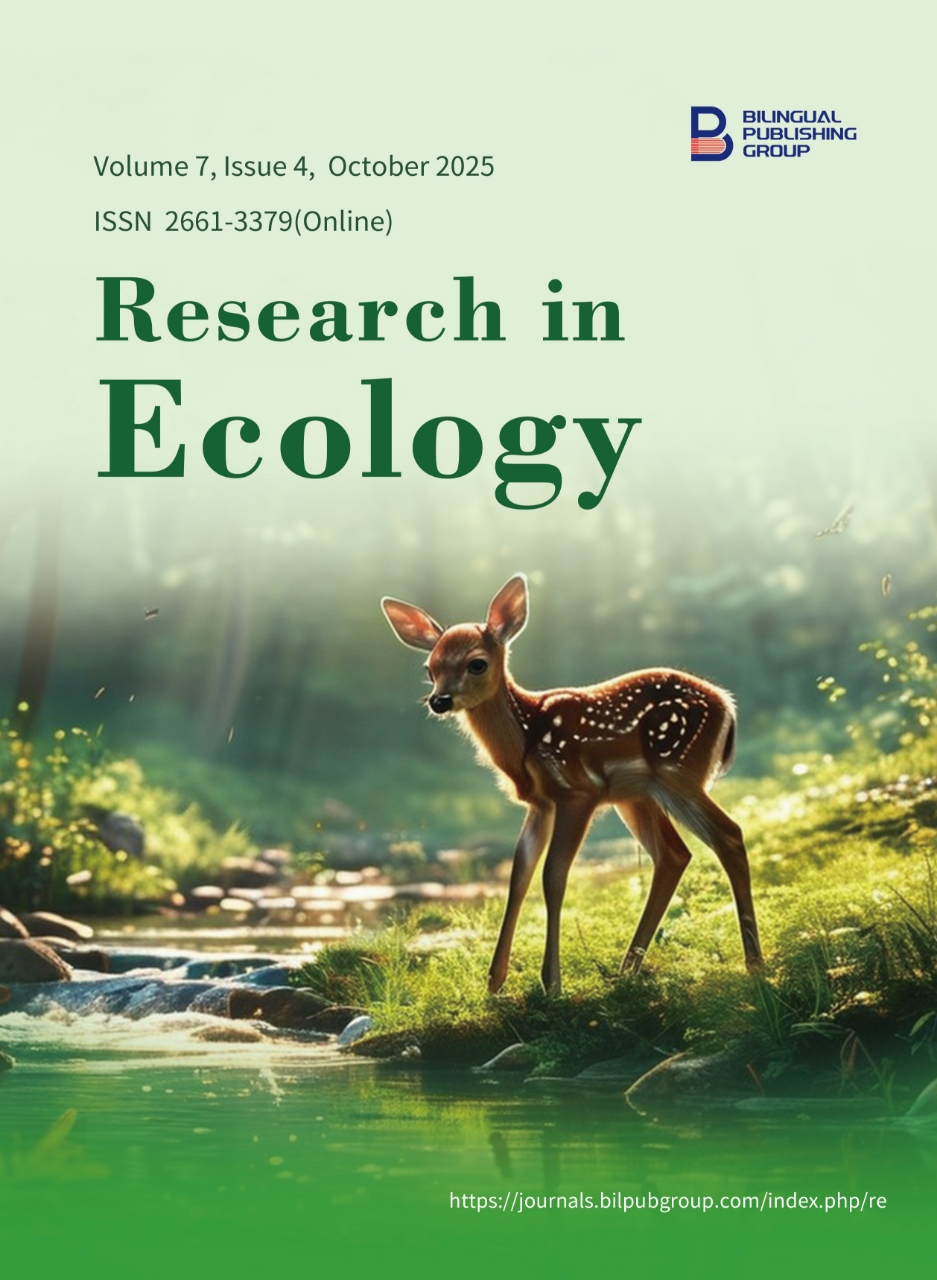
Integrating Machine Learning, Cellular Automata-Artificial Neural Network Model for Projecting Future Land Use Patterns in Urban Landscape of Jaipur, India
DOI:
https://doi.org/10.30564/re.v7i4.9819Abstract
Jaipur, India, is experiencing rapid urbanization that is significantly altering its land use and land cover (LULC) patterns, presenting both challenges and opportunities for sustainable development and socio-economic advancement. This study utilizes advanced geospatial and remote sensing technologies to assess these changes and project future scenarios. Specifically, satellite data were processed using Google Earth Engine, land cover was accurately classified using the Random Forest algorithm, and future projections were modeled through QGIS-MOLUSCE using a polynomial-based Cellular Automata–Artificial Neural Network (CA-ANN) approach. Analysis of Landsat imagery for the years 2000 and 2020 reveals a dramatic 188.59% increase in urban built-up areas and a 145.44% rise in vegetation cover, largely due to successful afforestation efforts. Meanwhile, barren land declined by 47.37%, and water bodies exhibited fluctuating trends, reflecting the intricate interplay between urban development and climatic variability. Looking ahead to 2045, model projections estimate that built-up areas will expand to approximately 1303.08 square kilometres, potentially threatening the integrity of vital green spaces and aquatic ecosystems. These findings highlight the urgent need for integrated policy interventions aimed at mitigating environmental risks such as urban heat island effects and biodiversity loss. By providing a detailed account of past and present LULC dynamics, this research delivers actionable, data-driven insights to support sustainable urban planning. Moreover, the integration of urban growth models with climate resilience strategies offers a replicable framework for managing urban expansion in other rapidly developing cities, particularly those situated in semi-arid regions.
Keywords:
Google Earth Engine; Machine Learning; Modules of Land Use Change Evaluation; Land Use Land CoverReferences
[1] Gharaibeh, A., Shaamala, A., Obeidat, R., et al., 2020. Improving land-use change modeling by integrating ANN with Cellular Automata–Markov Chain model. Heliyon. 6(9), e05092. DOI: https://doi.org/10.1016/j.heliyon.2020.e05092
[2] Food and Agriculture Organization, 2022. The State of the World's Land and Water Resources for Food and Agriculture: Systems at Breaking Point. FAO: Rome, Italy. DOI: https://doi.org/10.4060/cb9910en
[3] Ministry of Housing and Urban Affairs (MoHUA), 2022. Urban and Regional Development Plans Formulation and Implementation Guidelines (URDPFI). Government of India: New Delhi, India
[4] National Remote Sensing Centre (NRSC), 2021. Bhuvan: LULC Dynamics Report for Rajasthan. Indian Space Research Organisation: Hyderabad, India
[5] Huang, K., Li, X., Liu, X., et al., 2019. Projecting global urban land expansion and heat island intensification through 2050. Environmental Research Letters. 14(11), 114037. DOI: https://doi.org/10.1088/1748-9326/ab4b71
[6] Iqbal, M.F., Khan, I.A., 2014. Spatiotemporal land use land cover change analysis and erosion risk mapping of Azad Jammu and Kashmir, Pakistan. Egyptian Journal of Remote Sensing and Space Science. 17(2), 209–229. DOI: https://doi.org/10.1016/j.ejrs.2014.09.004
[7] Akın, A., Sunar, F., Berberoğlu, S., 2015. Urban change analysis and future growth of Istanbul. Environmental Monitoring and Assessment. 187(1), 1–15. DOI: https://doi.org/10.1007/s10661-015-4721-1
[8] Redowan, M., Phinn, S., Roelfsema, C., et al., 2022. Modeling forest cover dynamics in Bangladesh using multilayer perceptron neural network with Markov chain. Journal of Applied Remote Sensing. 16(3), 034502. DOI: https://doi.org/10.1117/1.JRS.16.034502
[9] Sivakumar, V., 2014. Urban mapping and growth prediction using remote sensing and GIS techniques, Pune, India. The International Archives of the Photogrammetry, Remote Sensing and Spatial Information Sciences. XL-8, 967–970. DOI: https://doi.org/10.5194/isprsarchives-XL-8-967-2014
[10] Baig, M.F., Mustafa, M.R.U., Baig, I., et al., 2022. Assessment of land use land cover changes and future predictions using CA-ANN simulation for Selangor, Malaysia. Water. 14(3), 402. DOI: https://doi.org/10.3390/w14030402
[11] Subedi, B.P., Khatiwada, A.P., Pandey, V.P., et al., 2013. Impact of land use and land cover changes on hydrology: A review. Water Resources Management. 27(1), 1–20.
[12] Tamiminia, H., Salehi, B., Mahdianpari, M., et al., 2020. Google Earth Engine for geo-big data applications: A meta-analysis and systematic review. ISPRS Journal of Photogrammetry and Remote Sensing. 164, 152–170. DOI: https://doi.org/10.1016/j.isprsjprs.2020.04.001
[13] Allam, M., Bakr, N., Elbably, W., 2019. Multi-temporal assessment of land use/land cover change in arid region based on Landsat satellite imagery: Case study in Fayoum Region, Egypt. Remote Sensing Applications: Society and Environment. 14, 8–19. DOI: https://doi.org/10.1016/j.rsase.2019.02.002
[14] Mozumder, C., Tripathi, N.K., 2014. Geospatial scenario-based modelling of urban and agricultural intrusions in Ramsar wetland Deepor Beel in Northeast India using a multi-layer perceptron neural network. International Journal of Applied Earth Observation and Geoinformation. 32, 92–104. DOI: https://doi.org/10.1016/j.jag.2014.03.002
[15] Adhikari, A., Hansen, A.J., 2018. Land use change and habitat fragmentation of wildland ecosystems of the North Central United States. Landscape and Urban Planning. 177, 196–216. DOI: https://doi.org/10.1016/j.landurbplan.2018.04.014
[16] Lukas, J., Grunewald, N., Schmitt, A., 2023. The role of population growth in land use changes: A global perspective. Land Use Policy. 120, 106117.
[17] Saputra, M.H., Lee, H.S., 2019. Prediction of land use and land cover changes for North Sumatra, Indonesia, using an artificial neural network-based cellular automaton. Sustainability. 11(11), 3024. DOI: https://doi.org/10.3390/su11113024
[18] Gündüz, H.İ., 2025. Land-use land-cover dynamics and future projections using GEE, ML, and QGIS-MOLUSCE: A case study in Manisa. Sustainability. 17(4), 1363. DOI: https://doi.org/10.3390/su17041363
[19] Kafi, M., Jahan, S., Rahman, M., 2014. Population growth and land use change: A case study of Dhaka City, Bangladesh. Journal of Environmental Science and Technology. 7(3), 187–195.
[20] Hazarika, N., Das, A.K., Borah, S.B., 2015. Assessing land-use changes driven by river dynamics in chronically flood-affected Upper Brahmaputra plains, India, using RS-GIS techniques. The Egyptian Journal of Remote Sensing and Space Science. 18(1), 107–118. DOI: https://doi.org/10.1016/j.ejrs.2015.02.001
[21] Vivekananda, G., Swathi, R., Sujith, A., 2021. Multi-temporal image analysis for LULC classification and change detection. European Journal of Remote Sensing. 54(sup2), 189–199. DOI: https://doi.org/10.1080/22797254.2020.1771215
[22] Zhang, P., Gong, M., Su, L., et al., 2016. Change detection based on deep feature representation and mapping transformation for multi-spatial-resolution remote sensing images. ISPRS Journal of Photogrammetry and Remote Sensing. 116, 24–41. DOI: https://doi.org/10.1016/j.isprsjprs.2016.02.013
[23] Bhunia, G.S., Chatterjee, U., Shit, P.K., 2021. Emergence and challenges of land reclamation: Issues and prospect. In: Modern Cartography Series, Vol. 10. Academic Press: Cambridge, MA, USA. pp. 1–15. DOI: https://doi.org/10.1016/B978-0-12-823895-0.00020-8
[24] Islam, M.S., Khatun, S., Kabir, M.H., et al., 2022. Monitoring of water quality with trophic state index (TSI) in the Chalan Beel wetland ecosystem of Bangladesh. Grassroots Journal of Natural Resources. 5(2), 80–103. https://doi.org/10.33002/nr2581.6853.050206
[25] Nagne, A.D., Vibhute, A.D., Dhumal, R.K., et al., 2019. Urban LULC change detection and mapping spatial variations of Aurangabad City using IRS LISS-III temporal datasets and supervised classification approach. In: Data Analytics and Learning. Springer: Singapore. pp. 369–386. DOI: https://doi.org/10.1007/978-981-13-2514-4_31
[26] Amgoth, A., Rani, H.P., Jayakumar, K.V., 2023. Exploring LULC changes in Pakhal Lake area, Telangana, India using QGIS MOLUSCE plugin. Spatial Information Research. 31(4), 429–438. DOI: https://doi.org/10.1007/s41324-023-00509-1
[27] Turner, W., Rondinini, C., Pettorelli, N., et al., 2015. Free and open-access satellite data are key to biodiversity conservation. Biological Conservation. 182, 173–176. DOI: https://doi.org/10.1016/j.biocon.2014.11.048
[28] Chen, J., Chen, Y., Zhang, Y., 2018. Remote sensing and GIS for land use change detection: A review. International Journal of Applied Earth Observation and Geoinformation. 64, 1–10.
[29] Turner, W., Spector, S., Gardiner, N., et al., 2003. Remote sensing for biodiversity science and conservation. Trends in Ecology & Evolution. 18(6), 306–314. DOI: https://doi.org/10.1016/S0169-5347(03)00070-3
[30] Zeshan, M.T., Mustafa, M.R.U., Baig, M.F., 2021. Monitoring land use changes and their future prospects using GIS and ANN-CA for Perak River Basin, Malaysia. Water. 13(16), 2286. DOI: https://doi.org/10.3390/w13162286
[31] Rahman, F., Rahman, M.T.U., 2023. Use of cellular automata-based artificial neural networks for detection and prediction of land use changes in North-Western Dhaka City. Environmental Science and Pollution Research. 30(1), 1428–1450. DOI: https://doi.org/10.1007/s11356-022-22079-9
[32] Zhu, Z., Zhou, Y., Seto, K.C., et al., 2020. Remote sensing of land use and land cover change: A review. Remote Sensing of Environment. 239, 111120.
[33] Shatnawi, N., Qdais, H.A., 2019. Mapping urban land surface temperature using remote sensing techniques and artificial neural network modelling. International Journal of Remote Sensing. 40(10), 3968–3983. DOI: https://doi.org/10.1080/01431161.2018.1557792
[34] Mastrorillo, M., Licker, R., Bohra-Mishra, P., et al., 2016. Urbanization and health: A systematic literature review. Environmental Research Letters. 11(12), 123004.
[35] Ravallion, M., 2016. The Economics of Poverty: History and Measurement. World Bank Publications: Washington, DC, USA
[36] Satterthwaite, D., 2017. Urbanization and its implications for food and nutrition security. Global Food Security. 15, 1–8.
[37] Seto, K.C., Güneralp, B., Hutyra, L.R., 2012. Global forecasts of urban expansion to 2030 and direct impacts on biodiversity and carbon pools. Proceedings of the National Academy of Sciences. 109(40), 16083–16088. DOI: https://doi.org/10.1073/pnas.1211658109
[38] Dewan, A.M., Yamaguchi, Y., 2009. Land use and land cover change in Greater Dhaka, Bangladesh: Using remote sensing to promote sustainable urbanization. Applied Geography. 29(3), 390–401. DOI: https://doi.org/10.1016/j.apgeog.2008.12.005
[39] Congalton, R.G., 1991. A review of assessing the accuracy of classifications of remotely sensed data. Remote Sensing of Environment. 37(1), 35–46. DOI: https://doi.org/10.1016/0034-4257(91)90048-B
[40] Shafizadeh-Moghadam, H., Asghari, A., Tayyebi, A., et al., 2017. Coupling machine learning, tree-based and statistical models with cellular automata to simulate urban growth. Computers, Environment and Urban Systems. 64, 297–308. DOI: https://doi.org/10.1016/j.compenvurbsys.2017.04.002
[41] Weng, Q., 2014. Global Urban Monitoring and Assessment through Earth Observation. CRC Press: Boca Raton, FL, USA.
[42] Li, X., Zhou, Y., Zhao, M., et al., 2020. A harmonized global nighttime light dataset 1992–2018. Scientific Data. 7(1), 168. DOI: https://doi.org/10.1038/s41597-020-0510-y
[43] Soares-Filho, B.S., Cerqueira, G.C., Pennachin, C.L., 2002. Dinamica—A stochastic cellular automata model designed to simulate the landscape dynamics in an Amazonian colonization frontier. Ecological Modelling. 154(3), 217–235. DOI: https://doi.org/10.1016/S0304-3800(02)00059-5
[44] Maurya, N.K., Rafi, S., Shamoo, S., 2023. Land use/land cover dynamics study and prediction in Jaipur City using CA Markov model integrated with road network. GeoJournal. 88, 137–160. DOI: https://doi.org/10.1007/s10708-022-10593-9
[45] Muhammad, R., Zhang, W., Abbas, Z., et al., 2022. Spatiotemporal change analysis and prediction of future land use and land cover changes using QGIS MOLUSCE plugin and remote sensing big data: A case study of Linyi, China. Land. 11(3), 419. DOI: https://doi.org/10.3390/land11030419
Downloads
How to Cite
Issue
Article Type
License
Copyright © 2025 Swati Gupta

This is an open access article under the Creative Commons Attribution-NonCommercial 4.0 International (CC BY-NC 4.0) License.




 Swati Gupta
Swati Gupta





